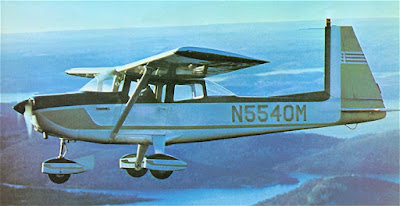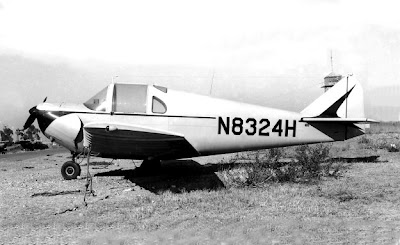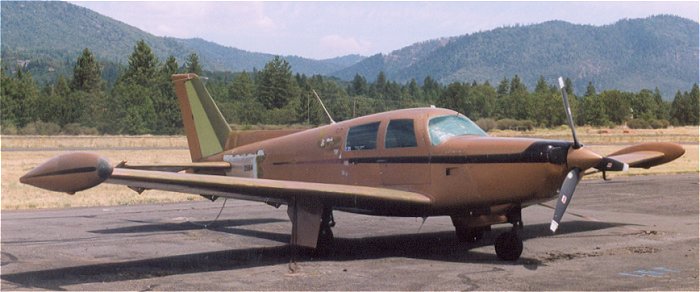You are using an out of date browser. It may not display this or other websites correctly.
You should upgrade or use an alternative browser.
You should upgrade or use an alternative browser.
When Airplanes Procreate
- Thread starter Hiperbiper
- Start date
DavidWhite
Final Approach
Why did they build such a thing?
Why did they build such a thing?
Because they could??

Seriously, I think it was their shot at the trainer market way back when, if I recall correctly. It's been a while since I read Ball's book on Mooneys.
RJM62
Touchdown! Greaser!
- Joined
- Jun 15, 2007
- Messages
- 13,157
- Location
- Upstate New York
- Display Name
Display name:
Geek on the Hill
Why did they build such a thing?
To enable it to spin.
Seriously.
The Ercoupe (the rights to which Mooney had purchased) was incapable of spinning due to the empennage and the way the yoke and rudder were linked (there were no rudder pedals, although some Ercoupes were retrofitted with them). Because of this, students who completed their pilot training in an Ercoupe had a limitation that said they could only fly aircraft that were incapable of spins.
Mooney wanted to market the M-10 as a general-purpose trainer, so they had to make it spinnable.
-Rich
nddons
Touchdown! Greaser!
What happens when the Big, Bad Mooney Ovation gets the hots for the little Ercoupe in the back of the hanger...
The Mooney M-10!
Eewww...
Chris
That looks like the Labradoodle of airplanes. It doesn't shed, er, spin, but it doesn't look very good either.
RJM62
Touchdown! Greaser!
- Joined
- Jun 15, 2007
- Messages
- 13,157
- Location
- Upstate New York
- Display Name
Display name:
Geek on the Hill
That looks like the Labradoodle of airplanes. It doesn't shed, er, spin, but it doesn't look very good either.
Again, it does spin.
That's why the empennage was changed: to enable it to spin.
-Rich
Greg Bockelman
Touchdown! Greaser!
- Joined
- Feb 23, 2005
- Messages
- 11,092
- Location
- Lone Jack, MO
- Display Name
Display name:
Greg Bockelman
Because they thought it would fill a need.
Pilawt
Final Approach
- Joined
- Sep 19, 2005
- Messages
- 9,479
- Display Name
Display name:
Pilawt
Later versions, from 1958 on, were built with full three-control arrangements as standard, keeping the original twin tail. These included the "Aircoupes" built by Forney (1958-60), Air Products Inc. (1961), and Alon (1964-67). Mooney acquired Alon, and the Ercoupe/Aircoupe design, in a stock swap in 1967. Mooney built around 40 of the twin-tail "A-2A Cadet" carried over from the Alon A-2A Aircoupe, then in 1969 began producing the "M-10 Cadet" with a new single tail obviously shaped to resemble the four-seat Mooney line. Ultimately only 59 M-10s were built.The Ercoupe (the rights to which Mooney had purchased) was incapable of spinning due to the empennage and the way the yoke and rudder were linked (there were no rudder pedals, although some Ercoupes were retrofitted with them).
According to Larry Ball (Those Magnificent Mooneys, p. 94),
" ... [T]he total rudder had actually been reduced from 6 sq. ft. to 5.63 sq. ft. But the rudder was slightly further aft, and deflection was now 26 degrees in either direction. On the original twin-tailed Ercoupe, all that was available was 20 degrees on the outward rudder and 3 degrees in."
Rich is correct: even with full rudder pedal controls, twin-tailed 'Coupes were incapable of spinning. The "Mooney-like" tail was engineered to allow the airplane to spin.
Hiperbiper
Line Up and Wait
Rich;Again, it does spin.
That's why the empennage was changed: to enable it to spin.
-Rich
I don't care if it would do the whole aresti catalog.
The Ercoupe is cute. P-38 tails and all...
The Mooney is small,fast and sexy.
The combo of the two is...well...truly Fugly!
Many threads have been devoted to favorite, pretty and sexy airplanes.
This one is not.
What are some of the ugly, crappy and most un-inspiring airplanes you're happy you've never had to walk up to and say: "God I hope nobody see's me flying this"?.
Both the Guppy series of airplanes and any design from Blom & Voss (1938-1945) are out-of-bounds. Too easy...
Pilawt
Final Approach
- Joined
- Sep 19, 2005
- Messages
- 9,479
- Display Name
Display name:
Pilawt
Well, there is another one, coincidentally, with a Mooney-like tail (Aero Commander 100 / Darter Commander) ...What are some of the ugly, crappy and most un-inspiring airplanes you're happy you've never had to walk up to and say: "God I hope nobody see's me flying this"?.

And the Emigh Trojan was a face only a mother could love:

Last edited:
Actually, the main thing that keeps an Ercoupe from spinning is that the elevator authority won't allow the thing to stall unless you work on it hard.The Ercoupe (the rights to which Mooney had purchased) was incapable of spinning due to the empennage and the way the yoke and rudder were linked (there were no rudder pedals, although some Ercoupes were retrofitted with them). Because of this, students who completed their pilot training in an Ercoupe had a limitation that said they could only fly aircraft that were incapable of spins.
I think there is exactly one Trojan flying and I run into him from time to time at Oshkosh, etc.... It's pretty distinctive when you get up close as the wing ribs are on the OUTSIDE of the wing skins.
Geico266
Touchdown! Greaser!
I think it is cute! Retract and all! 

RJM62
Touchdown! Greaser!
- Joined
- Jun 15, 2007
- Messages
- 13,157
- Location
- Upstate New York
- Display Name
Display name:
Geek on the Hill
Later versions, from 1958 on, were built with full three-control arrangements as standard, keeping the original twin tail. These included the "Aircoupes" built by Forney (1958-60), Air Products Inc. (1961), and Alon (1964-67). Mooney acquired Alon, and the Ercoupe/Aircoupe design, in a stock swap in 1967. Mooney built around 40 of the twin-tail "A-2A Cadet" carried over from the Alon A-2A Aircoupe, then in 1969 began producing the "M-10 Cadet" with a new single tail obviously shaped to resemble the four-seat Mooney line. Ultimately only 59 M-10s were built.
According to Larry Ball (Those Magnificent Mooneys, p. 94)," ... [T]he total rudder had actually been reduced from 6 sq. ft. to 5.63 sq. ft. But the rudder was slightly further aft, and deflection was now 26 degrees in either direction. On the original twin-tailed Ercoupe, all that was available was 20 degrees on the outward rudder and 3 degrees in."Rich is correct: even with full rudder pedal controls, twin-tailed 'Coupes were incapable of spinning. The "Mooney-like" tail was engineered to allow the airplane to spin.
I didn't know that the later Ercoupe models had full controls. My only personal experience with the Ercoupe was in one that someone tried to sell me years ago. It was in good condition and I actually had money back then, so I almost bought it, mainly for the "cuteness" and historical significance. It was emblematic of a time in aviation history when it was hoped that private airplanes might become as common as private automobiles.
But in practical terms, it was too darn tight inside and had too little useful load to accommodate my then-fatter hindquarters and all but the slimmest of passengers. It was designed during an era when people were smaller and slimmer.
The guy who tried to sell it to me was the one who related the M-10 information, by the way. I thought it interesting that Mooney (or anyone else) would modify an aircraft specifically to make it more spin-prone, but I guess it made sense given Mooney's interest in getting into the trainer market.
-Rich
Anthony
Touchdown! Greaser!
- Joined
- Feb 23, 2005
- Messages
- 18,478
- Display Name
Display name:
Anthony
I think it is cute! Retract and all!
It's not a retract. It is a fixed gear trainer. I don't find it overly offensive either.
Pilawt
Final Approach
- Joined
- Sep 19, 2005
- Messages
- 9,479
- Display Name
Display name:
Pilawt
Piper did likewise with the PA-38 Tomahawk. From Wikipedia:I thought it interesting that Mooney (or anyone else) would modify an aircraft specifically to make it more spin-prone, but I guess it made sense given Mooney's interest in getting into the trainer market.
Before designing the aircraft, Piper widely surveyed flight instructors for their input into the design. Instructors requested a more spinnable aircraft for training purposes, since other two-place trainers such as the Cessna 150 and 152 were designed to spontaneously fly out of a spin. The Tomahawk's NASA GA(W)-1 Whitcomb airfoil addresses this requirement by making specific pilot input necessary in recovering from spins, thus allowing pilots to develop proficiency in dealing with spin recovery.
Pilawt
Final Approach
- Joined
- Sep 19, 2005
- Messages
- 9,479
- Display Name
Display name:
Pilawt
My dad got this photo at Grants Pass in the late 1990s. It's one of the more interesting combinations of aeronautical DNA -- 1967 Mooney M20E Super-21 fuselage, Beech Musketeer vertical fin & rudder, Mooney-Aerostar-based wing (i.e., from a Mooney built during the Butler regime), engine from a Cessna 337, and Beech tip-tanks. Unfortunately the airplane and all aboard were lost in a stall-spin accident in 2007.


jpower
Cleared for Takeoff
My dad got this photo at Grants Pass in the late 1990s. It's one of the more interesting combinations of aeronautical DNA -- 1967 Mooney M20E Super-21 fuselage, Beech Musketeer vertical fin & rudder, Mooney-Aerostar-based wing (i.e., from a Mooney built during the Butler regime), engine from a Cessna 337, and Beech tip-tanks. Unfortunately the airplane and all aboard were lost in a stall-spin accident in 2007.

Any info about how it performed?
Pilawt
Final Approach
- Joined
- Sep 19, 2005
- Messages
- 9,479
- Display Name
Display name:
Pilawt
According to a "for sale" ad just a few months before the airplane was wrecked, "Cruises 180 mph at 10-11 gph, with 94 gallons fuel."Any info about how it performed?
Graueradler
Pattern Altitude
Hiperbiper
Line Up and Wait
At least the Mooney and the Ercoupe had the good manners to do it in private...


that's just rude.
Last edited:
denverpilot
Tied Down
Because they thought it would fill a need.
Kinda like Windows 8. Heh heh.
denverpilot
Tied Down
My dad got this photo at Grants Pass in the late 1990s. It's one of the more interesting combinations of aeronautical DNA -- 1967 Mooney M20E Super-21 fuselage, Beech Musketeer vertical fin & rudder, Mooney-Aerostar-based wing (i.e., from a Mooney built during the Butler regime), engine from a Cessna 337, and Beech tip-tanks. Unfortunately the airplane and all aboard were lost in a stall-spin accident in 2007.

And OMG Fugly in brown.
RIP to the folks killed.
Those are later model Osborne tip tanks. While they have a Beech STC available, they are more properly NAVION tip tanks (the Osborne's are Navion guys first). The tanks area available for several aircraft including Bonanzas and Comanche's.
flyingcheesehead
Touchdown! Greaser!
My dad got this photo at Grants Pass in the late 1990s. It's one of the more interesting combinations of aeronautical DNA -- 1967 Mooney M20E Super-21 fuselage, Beech Musketeer vertical fin & rudder, Mooney-Aerostar-based wing (i.e., from a Mooney built during the Butler regime), engine from a Cessna 337, and Beech tip-tanks. Unfortunately the airplane and all aboard were lost in a stall-spin accident in 2007.

How does one build such a beast? What kind of airworthiness certificate did it have?


